Football is the most popular sport in the world. That's a fact. It's so popular that many fans have dedicated their lives to it, or even, as Bill Shankly would like them to, consider it more important than life and death. It's not a surprise to see fanatics who always put their teams first.And yet, despite all that, we come across stories of certain fans who surprise us with their unwavering and dedicated support to their favourite teams - support for which they have earned fame the world over. Here are 7 football crazy fans who have become famous in their own right (in no particular order):
#1 Manolo, el del Bombo (Spain)
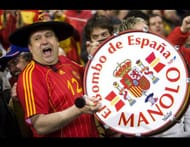
First up on the list, is a man with a drum that is as famous as him. Manuel Cáceres Artesero, popularly known as ‘Manolo, el del Bombo’ (Manolo, the one with the Drum), is the Spanish national team’s foremost supporter. Ever since hitch-hiking 16,000 km to watch Spain during the 1982 World Cup on home soil, Manolo has made it a point to follow the team wherever they play. He has since become a recognizable symbol of the team, so much so that the Royal Spanish Football Federation now pays for his travels and gives him access to the squad.
When not in tow with the Spanish team, Manolo runs a bar facing Valencia’s Mestalla Stadium. The bar doubles up as a football museum of sorts, with souvenirs and photos from his three-decade long journey with Spain. Visitors frequent the bar to see him and his famous drum. Manolo uses the drum to send out a positive message to other fans: on one side it is written: Sport yes, violence no.
#2 Clement d\'Antibes (France)
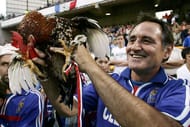
In a way, Clement Tomaszewski is like the French national team. Like many members of the squad, he is of multicultural origin, having been born in Algeria to a Spanish mother and a Polish father. But despite their foreign origin, they share loyalty and undying love for France. It is something that has made Clement ‘le supporter numero uno’ of France.
Although he has followed the national team since 1982, Clement captured national attention during the 1998 edition, when France won the title for the first time. Thereafter, he was recognized in the media as ‘Clement d’Antibes’ (Clement of Antibes), a reference to his hometown of Antibes in southeastern France. He has appeared at all of France’s matches ever since, alongside his pet rooster Balthazar, representing French football’s offical emblem.
Having attended the 2014 World Cup, Clement feels that Russia ‘18 will be too ardous a task for his ageing body. He hopes of ‘retiring’ after Euro 2016 to spend his remaining days with his grandchildren and his bonsai plants. He does admit that watching France on TV will be weird!
#3 El Cole (Colombia)
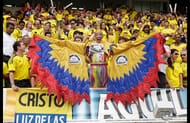
Introducing ‘El Cole’: an unmissable part of the galllery during any Colombia match in recent history. His real name is Gustavo Llanos and he is one of Colombian football’s iconic names without having any role on the field. He attends every Colombia game dressed like a condor (Colombia’s national symbol) in fantastic costumes of red, blue and yellow feathers. It doesn’t just stop there, El Cole has also performed daredevil stunts by attaching himself to a rope and appearing to fly in the stadium.
Llanos’s passion for Colombia is special: he dropped out of law school to follow his team. In 1990, he made his way to Italy having spent a fortune on the airfare. While he was there, he had to sleep in train stations and in the streets. He didn’t mind, as long as he was able to support his beloved Colombia.
The long absence of Colombia from the World Cup since 1998, saddened Llanos but it didn’t stop him from attending each of the tournaments. He just loves the atmosphere in the stadium and has been contributing to it in his own condor-like ways.
#4 Gaucho de Copa (Brazil)

The above image will undoubtedly remain immortal as one of the lasting memories of the 2014 World Cup – a Brazilian fan crying, while clutching a World Cup replica trophy.
He is Clovis Fernandes, a Brazilian real estate agent, popularly known as ‘Gaúcho da Copa’ - 'Cowboy of the Cup." The nickname stems from his cowboy hat and boots, which represent his home state of Rio Grande de Sul. Clovis has been, by his own definition, the Brazilian national team’s 12th man since the 1990 World Cup in Italy. He always finds time off from work to travel around the world, wherever Brazil are playing. This passion has taken him to over 60 countries and more than 140 Brazil matches.
A replica trophy is the Cowboy’s constant companion; he takes it to every match. In the WC ‘14 semifinal against Germany, after being reduced to tears by the 7-1 humiliation, Clovis reportedly handed over his replica to a young German fan, telling her: "Take it to the final! As you can see, it is not easy, but you deserve it, congratulations!"
#5 Khaled Hurriyya (UAE)
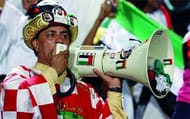
Khaled al-Hammadi is the owner of a restaurant in the city of Sharjah in the UAE. The restaurant is popular, but not quite as much as the man himself – an ever-present figure in the gallery when UAE’s national football team play. For almost 40 years, Khaled has been a dedicated supporter of the Whites, regularly turning up at matches decked in the national colours and holding a megaphone. Today, his popularity extends to appearances in advertisements and promotional videos.
Khaled’s sojourn to eventually become the face of UAE’s fandom began in 1974 when he first attended a match involving the team. It was a tough task for him as he hailed from the remote town of Khor Fakkan. Public transport was non existent, yet Khaled always found a way to get to the distant cities of Dubai and Sharjah. This gave rise to the title ‘Hurriyya’ or ‘Freedom’, as people saluted his free and indomitable spirit.
The title stuck and today it is the name of a street in his hometown and also more importantly, of his restaurant.
#6 Oranje Generaal (The Netherlands)
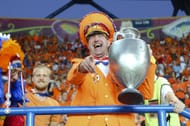
After the 2014 World Cup third place playoff, TV cameras followed the Netherlands captain Robin Van Persie as he walked over to the crowd and handed his bronze medal to a fan. That man’s name is Winfried Witjes, more commonly known as ‘Oranje Generaal.’
Witjes leads a relatively simple life as a clothing store manager in the Netherlands but turns into his alter ego whenever his national team play. Dressed in orange military uniform, he has been a recognizable member of the Dutch crowd for a long time, leading to a celebrity status at home. It came into focus in 2014, when Witjes was said to be unable to make it to Brazil for the World Cup. Almost immediately a website was set up by fans to raise money for the General’s World Cup trip. The efforts paid off and Witjes managed to lead the Dutch support at all of their World Cup games.
#7 Ivan Bogdanov (Serbia)
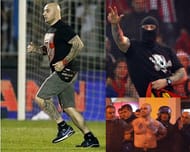
For those of you who know him: yes, I agree he is not the most model supporter in the world but he finds a place in this list for all the wrong reasons – due to the fame (or infamy, rather) that he has achieved over the years.
For those of you who don’t know him: Ivan Bogdanov is the most notorious hooligan in the world. With a track record of inciting violence and crowd trouble in his country of Serbia and beyond, Bogdanov is one of the leaders of the hardcore Ultra Boys fan group that supports Red Star Belgrade. He is also a part of the right-wing nationalist Movement 1389, a group that has fought against ethnic Albanians.
In 2010, a Euro 2012 qualifier between Italy and Serbia in Genoa was called off after Serbian fans threw flares onto the pitch and into the Italian fan enclosure. Leading the action was Bogdanov who sat on a fence with a wire cutter in his hands. He burned an Albanian flag, performed a fascist salute and egged on the unruly fans. It was an incident that saw his arrest and sentencing to three years in prison. He and his friends also reportedly targetted Serbian keeper Stojkovic for leaving to join Partizan, the arch-rivals of Red Star. Stojkovic subsequently withdrew from the match.
He returned to prominence once again when he invaded the pitch during the mass brawl in the recent Serbia – Albania Euro 2016 qualifier.
